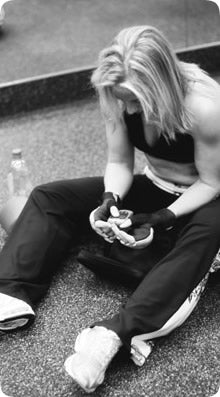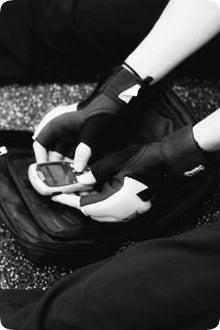   |
ABOUT THE DESIGNER
Fourteen-year-old girls usually don’t think or know much about diabetes. Yet, for a week I tried to convince my parents that being exhausted and thirsty, urinating all the time, and having blurry vision meant I had diabetes-- not the flu. I figured out that I had diabetes and how to start to cope with the biggest challenge of my life thanks to a “gift from God”-- a novel I read, when I was twelve, about a young boy with diabetes. I was finally admitted to the hospital with a blood sugar of 870 protesting: “I can’t stay overnight. I don’t have my make-up for school tomorrow!” Other concessions followed.
Just as soon as I began to learn the nuts and bolts of how to manage diabetes, I became focused on continuing to do the things I enjoyed, but was afraid that I would have to do it on my own. Being somewhat of a perfectionist proved to be helpful, but also made me anxious about getting everything right. My biggest immediate challenge that has shaped my life and outlook about diabetes was how to continue to pursue my passion and involvement in sports—of all types and for all seasons. I was on my high school soccer, ski, and track teams, and competed in gymnastics. I traveled regularly to out of state meets and tournaments. Many doctors warned my parents and me that Type 1 diabetes was very difficult to control in general and even more difficult manage when participating in competitive sports. Additionally, we were told that bad control lead to long-term complications. Did this mean that if I continued to compete in sports that I would not live as long as if I did not? I turned out not to be a typical adolescent with Type 1 diabetes. I monitored myself frequently and through trial and error, throughout high school, maintained my weight and avoided becoming profoundly hypoglycemic or ketoacidotic. Once I entered college, I went through a rather delayed adolescence. My lifestyle became more sedentary. I took more insulin and my weight and A1c levels increased. I was not satisfied with my appearance and had a very hard time looking at my blood sugar readings. My defining moment came when my rarely critical and very kind father as an expression of “tough love” said, “If you do not take control over your diabetes, it is going to eat you up and spit you out!” From that point forward, I decided to make exercise one of my life’s priorities, learned how to use it to enhance my control, and set out on a mission to help others, particularly those with Type 1 diabetes, do the same. I applied my high school diabetes “lessons”, regained control, graduated with a business degree from the University of New Hampshire and entered the workforce. At 24, I took a hiatus from corporate America, moved to LA from the East Coast, trained regularly, and became a successful certified personal trainer. Two years later, I returned to the East Coast. My endocrinologist switched me from NPH to Lantus, which smoothed out my blood sugar levels. With some guidance from my endocrinologist and lots of self-directed reading, control-- and in many ways life-- became easier. My weight was easier to control. I had less hypoglycemia. I could eat when I wanted to and found it much easier to regulate my sugars when I exercised. I then decided, with the help of my endocrinologist, to capitalize on what I learned firsthand about managing diabetes while engaging in many types of regular and often intense exercise. I became a Sanofi-Aventis sales representative specializing in Lantus. I regularly speak with CDE’s, nurses, medical assistants and physicians about how to strive for optimal control and the challenge exercise is for Type 1 diabetics. I attend and run support groups for those with diabetes featuring “A1c Champion Speakers”, patients whose A1c’s are below 7.0. My latest exercise passion is the fastest growing women’s fitness trend on the East Coast, Sweat Box (www.sweat-box.com)--The first martial art form ever designed for women. It is a fusion of boxing, hip-hop dance, and martial arts. I currently train six days a week with its creator, K.L. Brown, in Boston, MA. This particular exercise regimen has been a huge variable in gaining the best control of my diabetes. Sweat box has motivated me to lose weight, lower my A1C levels, remain consistent, and love life! | |||
|
What I tell those with Type 1 diabetes about exercise: SOME BROAD STROKES:
|
||||